Materials
The Ultimate Iron Wall Art Guide: Styles, Finishes, Hanging, and Décor Ideas
Forget mass-produced prints and predictable palettes! Iron wall art bursts onto the scene with unyielding character and raw beauty. Its unique blend of industrial grit and artistic expression captures hearts and spaces. Iron pieces offer versatility rarely found in other media, from the hand-forged charm of a rustic blacksmith piece to the sleek lines of modern laser-cut designs.
But let’s face it: Navigating the world of iron wall art can feel like exploring a blacksmith’s workshop blindfolded. Polished, distressed, figurative, abstract—the options seem endless! Fear not! This guide is your key to unlocking the secrets of iron art, from its diverse types, textures, styles, and finishes to selecting the perfect piece that matches your style.
Read on to find more, including ideas for incorporating iron into your home décor and care and maintenance tips.
What is Iron Wall Art?
Iron wall art refers to decorative iron pieces designed to be hung on interior or exterior walls. Iron has been used in artwork and ornamentation for centuries and is known for its durability, strength, and timeless beauty.
Modern iron wall art includes many options, from contemporary laser-cut panels to traditional cast iron medallions.
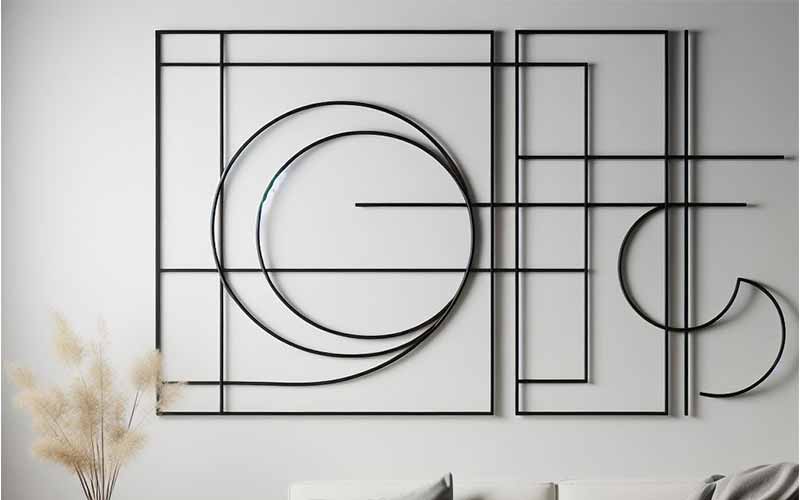
Unique Properties of Iron
Iron’s distinct characteristics make it appropriate for stunning artistic wall applications. Here are some of the properties that allow iron metal to be shaped into beautiful, long-lasting wall art:
- Strength and Durability: Iron is highly tensile and durable, maintaining intricate shapes without warping or breaking. Quality iron wall art can last for generations.
- Malleability: Iron can be hammered, pressed, and squeezed without cracking or fracturing. This allows it to be shaped into thin sheets or embossed with small details.
- Weldability: Iron pieces can be joined together through welding and soldering. This enables delicate lattices, frameworks, and multi-layered textures.
- Patina: When exposed to weather, iron develops a rust-colored patina. This natural aging lends antique, rustic charm.
Although iron’s versatility and timeless beauty make it a go-to choice for interior and exterior wall art that endures for generations, it does come with a few drawbacks, including;
- Heavy and bulky, difficult to hang, and may require special hardware
- Can corrode and rust if not properly sealed and maintained
- Cold, hard material lacks fabric texture interest
- It is expensive to commission custom pieces
- Limited color options
Further Reading
- 8 Pro Tips to Choose the Perfect Metal Wall Art for Your Space
- Exploring the Different Metals Used for Wall Decor
Types of Iron Metal Wall Art
There are many techniques used to shape iron into wall art. Here are some of the most popular categories of iron wall art based on production method:
Cast and Forged Iron Wall Sculptures
Cast iron starts as molten iron is poured into molds and then allowed to cool and harden. This creates intricate 3D shapes like wall-mounted medallions, sconces, and decorative reliefs.
Forged iron is heated and hammered into shape using brute force. Forging imparts a hand-crafted, imperfect beauty and allows custom designs.
Laser Cut Iron Wall Panels
Computer-guided lasers cut iron sheets into delicate openwork designs, such as filigree patterns, fretwork, or iron screens. This technique allows for exact, complex shapes.
Wrought Iron Wall Hangings
Wrought iron is heated, then bent and twisted into shape. This technique lends graceful, fluid lines to ironwork resembling vines, flowers, and nature.
Machined and Embossed Iron Wall Plaques
Milling, planing, and engraving tools chisel texture and bas relief into iron boards. Embossing presses patterns into sheet iron.
Iron Art Finishes
The final finish plays a significant role in the look and feel of iron wall art. Here are some regular iron finishes:
- Raw iron: This is unfinished iron in a dark, steely gray color. Over time, it will develop a natural patina.
- Painted: Iron finished with coatings like powders, primers, or enamels in any color.
- Oiled: Penetrating oil finishes protect iron while allowing some patina. Popular oils are linseed and tung.
- Waxed: Wax finishes add shine and moderate protection. Must be periodically reapplied.
- Distressed: Iron is intentionally rusted, scratched, or cracked. This finish looks naturally aged.
- Galvanized: A zinc coating is applied to iron to prevent extensive rust. Galvanized iron has a matte gray look.
Exploring the Iron Textures
Surface textures add visual interest and reinforce the properties of iron. Here are some textures seen in iron wall art:
- Smooth: Molten iron casts and machine-cut panels have seamless, glass-like surfaces.
- Hammered: Hammering iron by hand creates divots and indentations for an uneven, pitted texture.
- Chiseled: Iron can be engraved and chiseled to produce marks, grooves, and etched textures.
- Corroded: Natural or artificial rust textures iron with porous, peeling, flaky surfaces.
- Patina: Weathering creates a variegated patina with mild spotty rust.
- Gritty: Iron is blasted with metal grains to produce a coarse, gritty feel.
Iron Metal Wall Art Styles
Iron’s versatility allows it to be styled in many decorative directions. Here are some popular genres of iron wall art:
Abstract Iron Wall Art
This style uses non-representational shapes like zigzags, waves, spirals, and loops for modern flair. Negative spaces and simplicity create impact.
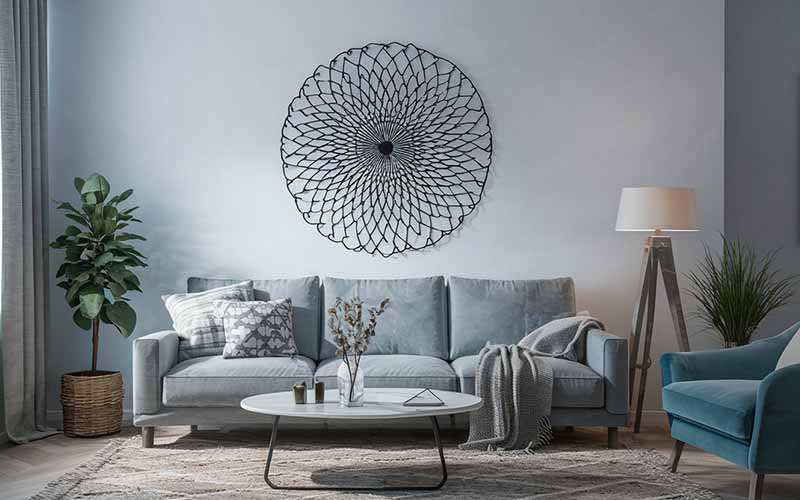
Geometric Iron Wall Sculptures
This style emphasizes symmetry and pattern. It takes rectangular, triangular, and hexagonal shapes into repetitive, mathematical compositions.
Nature-inspired Iron Wall Hangings
Flowing, organic shapes based on vines, leaves, flowers, feathers, coral, and ocean themes celebrate the beauty of nature.
Rustic and Industrial Iron Wall Plaques
Raw, unrefined iron textures and materials reference machinery, Manual tools, and aged factory elements to achieve a rugged look.
Incorporating Iron into Home Décor
Careful thought around iron wall sculpture groupings and supplemental decorative elements ensures a showstopping impact rather than overwhelming spaces.
Living Room Ideas
Cluster smaller iron starbursts, molecular formations, and smooth wave sculptures in a shadowbox-framed branching arrangement across large living room walls for an intriguing metalwork “gallery wall” effect around seating areas and hearths.
Alternatively, you can prominently position singular iron tree silhouettes or an abstract torso as the anchor piece. Then, harmonize additional décor like side tables, area rugs, and accent pillows with coordinating finishes and tones.
More ideas:
- Bold iron sculpture or geometric medallion above the mantel
- Statement circle iron wall hanging behind the sofa
- Triptych of abstract iron panels on an accent wall
Bedroom Concepts
Waking to intricate candlestick pieces with rear-lit opaque glass spheres glowing warmly bedside instantly soothes while channeling an enchanted forest.
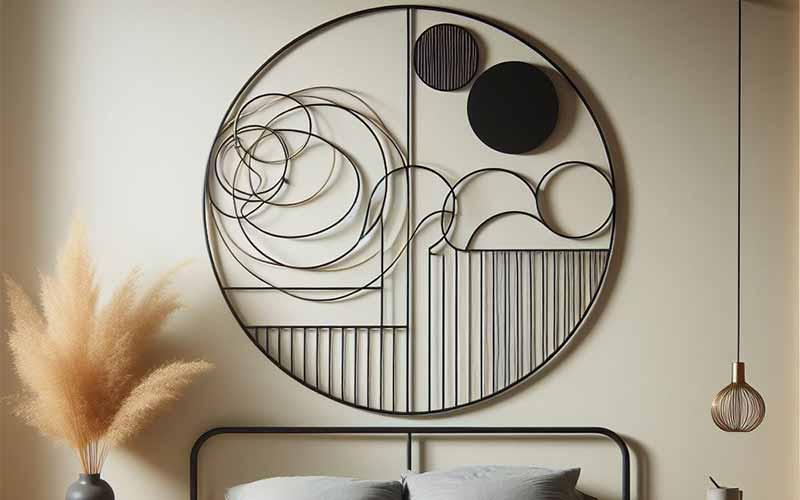
For more modern sanctuaries, outline minimalist linen tufted headboards with geometric iron frameworks doubling as wall anchors. You can also try out;
- Branching vine headboard relief
- Minimalist laser-cut iron screens around the bed
- Round cast iron botanical mirror over dresser
Kitchen and Dining Iron Accents
From handsome hand-hammered pot racks mounted across cooking range focal points to custom embossed menu signs showcasing chef’s specialties by dining room entrances, iron makes staying inspired and serving daily feasts an artful joy!
- Framed pressed tin panel displaying fruit and herbs
- Rustic cog and gear iron wine rack
- Hammered iron utensil silhouette
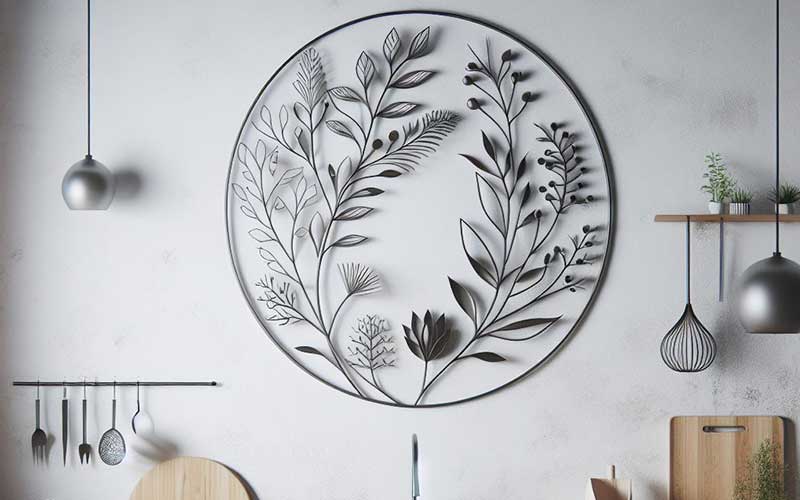
Bathroom Wrought Iron Wall Hangings
- Ocean-inspired iron wave above toilet
- Filigree iron sconces flanking the mirror
- Iron flower medallion over towel hooks
Black Iron Finishes for Dramatic Contrast
Powder-coated, painted, or oiled iron in black makes an eye-catching contrast against light walls. To accentuate iron designs, try painting recessed shelves or panels black.
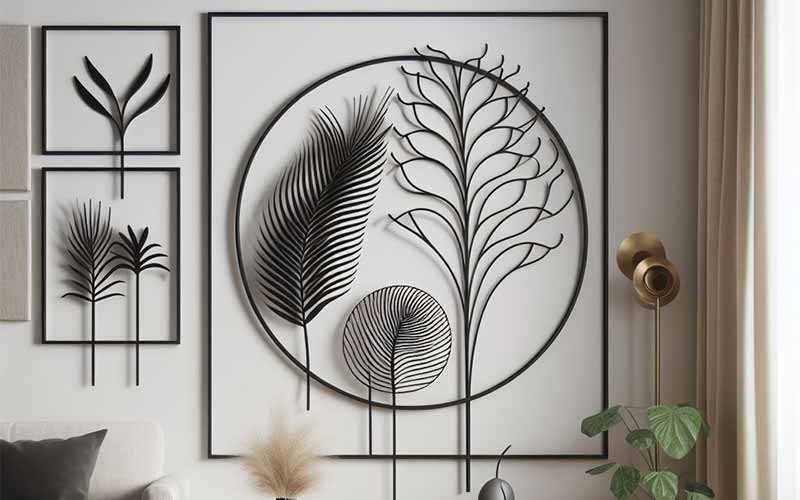
Matching Iron Wall Art Frames and Fixtures
Select iron wall art that complements iron furnishings and architectural accents to create a cohesive look. For example, a filigree iron chandelier matches layered laser-cut wall panels.
Complementary Accent Colors with Iron
While black is classic, don’t overlook iron designs with hits of color for a more eclectic effect. Paint or powder coat portions of iron art in bold hues or select furnishings with fun colors.
More tips to consider:
- Group creatively. Cluster small iron sculptures in asymmetrical gallery arrangements for interest.
- Anchor with bold art. Make a commanding iron piece the focal point, surrounded by complementary accents.
- Display iron with purpose. Use it to define spaces, add privacy, conceal eyesores, or make artistic statements.
- Harmonize finishes. Unify look with iron fixtures, furnishings, and decor in similar finished metal tones.
- Illuminate effectively. Spotlight iron textures and designs for maximum visual impact. Consider backlighting.
- Share histories. Curate antique or custom iron pieces that communicate memories and meaning.
Selecting Your Iron Masterpiece for your Walls
Now that you know about the diverse world of iron wall art, it’s time to find the perfect piece to grace your walls. Selecting the ideal iron art requires carefully weighing several essential factors:
Complement Your Style/Personal Taste
Take time to evaluate how the iron art fits within your existing décor and design goals. As noted earlier, Iron art comes in diverse styles, from modern geometric to abstract organic.
Consider the mood you want to create—sleek urban edge or cozy rustic charm? Ensure the iron piece complements your color scheme, furniture, and overall motif.
The art should enhance your style vision, not clash with it. Browse options and curate pieces that reflect your unique aesthetic.
Scale and Proportions
Proper scale and proportions are critical for both aesthetic appeal and secure mounting. Carefully measure the dimensions of your wall or installation area.
Oversized iron art can feel imposing and overwhelm a small space. Conversely, a tiny piece gets lost on an expansive wall.
As a general rule, choose iron art that is at least 2/3 the width of your wall. For groupings, have the outer pieces reach 2/3 across.
Most artists and retailers provide exact sizing info to help visualize scale. You can also sketch mockups to experiment with different placements.
Adjust downsizing for intimate settings like bathrooms or tight hallways, where smaller-scaled iron accents better suit the cozy proportions.
Display Location and Lighting
Note where your iron art will be situated and the lighting conditions. Is it well-lit and viewable up close, or is it placed in a discreet alcove or distant corner?
Highly polished and reflective iron finishes look stunning in bright, direct lighting. Meanwhile, darkened waxes and textured, distressed iron surfaces often fit better in intimate, indirectly lit settings.
Aim for placement that highlights the art’s defining textures and forms to maximum effect. At the same time, remember to check for glare if you intend to place it near lamps or windows.
Outdoor Factors: Here are some helpful tips for rust-free exterior iron art;
- Unsealed iron will naturally rust outside. Select outdoor rated iron or properly seal pieces.
- Add a cover or overhang to shield the art from the harshest direct sun and rain.
- North-facing walls create ideal shaded, indirect light for outdoor iron.
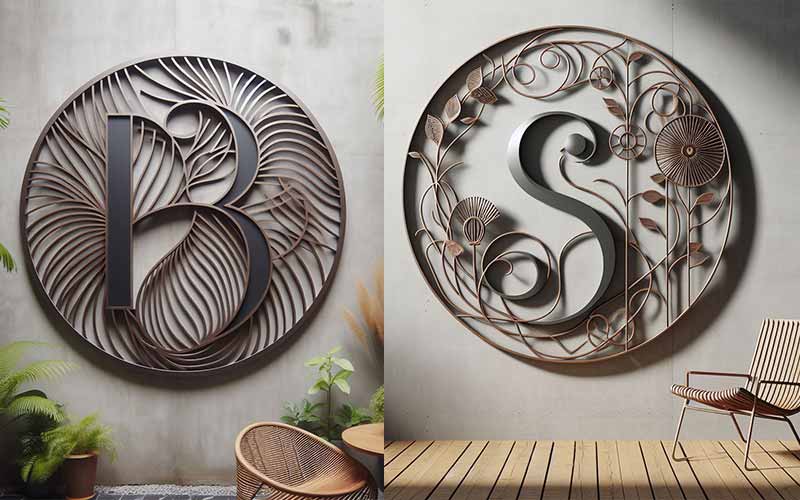
Remember, careful attention to display location enhances your art’s striking impact.
Functional or Decorative?
Determine whether the iron art will serve a purely decorative purpose or if it must meet functional needs, such as defining spaces, adding privacy, or concealing eyesores.
Multi-panel screens or prominent statement pieces help divide open floor plans. Strategically placed iron art can mask utility areas or cover flawed walls.
Select great art that fulfills your spatial, utility, and privacy needs.
Weight Load
Assess the wall and hardware needed to support heavy iron art:
- Wall mounting on studs or masonry using specific heavy-duty brackets and anchors provide the most security.
- Hanging hardware like French cleats or reinforced rails offer adjustable height and spread weight across multiple studs.
- Smaller decorative iron plaques may only require mollies and screw-in hooks. Use anchoring that is appropriate for the iron’s weight.
Set a Realistic Budget
With so many handcrafted and mass-produced options, you can find beautiful iron art at most budget levels. Evaluate your target price point, and then look for quality pieces that offer value and appeal within your budget.
Handmade artisan ironwork commands higher pricing due to intensive labor and customization. Mass-manufactured iron wall décor, on the other hand, provides budget-friendly standard sizes and designs.
Focus more on how the art fits your decor style and less on being the absolute lowest-cost option. Do your research to discover iron wall art that gives you the most design impact per dollar.
Finding the perfect wall-iron art that fits your style, space, location, and budget will help create a striking and meaningful focal point you’ll enjoy for years to come.
Creating Your Own (DIY) Iron Masterpiece
For the adventurous souls, this section might spark your interest! Crafting intricate iron art requires advanced skills and equipment; even beginners can explore creative DIY projects. Consider:
- Upcycling old metal objects: Transform discarded tools, gears, or bicycle parts into unique wall art to breathe new life into them.
- Simple metalworking projects: Online tutorials and workshops can help you create geometric shapes, leaves, or abstract designs using sheet metal and essential tools.
- Collaborative art: Partner with a local blacksmith or metalworking artist to design and personalize your iron wall art piece.
How to Hang Iron Wall Art
Here are some tips for hanging iron wall art:
- Assess the weight and size of your iron piece. Larger and heavier art will require more robust mounting solutions.
- Locate wall studs using a stud finder. Mounting directly into studs provides the most secure base for heavy iron art.
- For added strength, use specific heavy-duty hanging hardware designed for ironwork. Options include French cleats, reinforced picture rail systems, or specialty metal art hangers.
- If not mounting into studs, use appropriate wall anchors and materials like molly bolts or toggle bolts when securing to drywall. Match anchors to the iron art’s weight.
- Remember to follow the hardware manufacturer’s instructions carefully when installing mounting rails, brackets, and hangers. Measure twice and level for professional results.
- Balance off-center iron art by securing asymmetric hanging wires to both sides. Or add dual hooks to spread the weight.
- Outdoors, apply weatherproof adhesive mounting putty or tape to hang iron art on surfaces like stucco or concrete where drilling may be difficult.
- Consider heavy-duty command strips and hooks if surface mounting is preferred for more miniature iron decor like sconces or plaques.
Caring For and Protecting Iron Wall Art
Iron wall art is built to last for many years. However, maintaining its beauty and extending its lifespan requires special care and maintenance. Here are some tips and ideas:
Protecting Indoor Iron Wall Art
When exposed to excess moisture, indoor iron wall art is susceptible to corrosion and rust. Here are some tips to prevent damage:
- Avoid placing iron wall art directly next to sources of moisture, such as appliances, sinks, bathtubs, indoor pools, and spas. The humidity in these areas can cause condensation.
- Use mortar or caulk to seal any exterior moisture leaks behind wall-mounted iron art. Even small leaks in humid climates can corrode iron over time.
- Consider applying a thin, protective wax coating to indoor iron about once a year. The wax minimizes the iron’s contact with ambient moisture in the air.
- For bathrooms and basements, look for iron wall art with highly rust-resistant finishes, such as galvanization or thick epoxy powder coating. These extra protections make them suitable for damp areas.
Weatherproofing Outdoor Iron Wall Art
Outdoor iron art requires sealing and preparation to withstand the elements:
- Choose iron materials labeled as outdoor/exterior grade. Various alloys resist corrosion better than bare iron.
- Apply a weatherproof sealant such as marine epoxy formulated for metals every 6-12 months. The sealant entirely encapsulates the iron, preventing oxidation.
- Use linseed oil outdoors to achieve a natural, rustic patina. It enables you to control the aging process while safeguarding against considerable damage. Remember to reapply the oil every 2-3 months.
- Galvanization or powder coating offers the most heavy-duty protection for outdoor iron art. Zinc galvanization resists corrosion for decades, while powder coating plasticizes the iron with an impermeable barrier.
Restoring Rusted Iron Wall Art
Over time, all iron will accumulate some level of rust patina. To restore heavily oxidized iron wall art:
- Use a wire brush or gentle sandpaper to remove loose, flaky rust. Don’t scrub too hard, as this can scrape the iron underneath.
- Clean with mild soap and water, and then fully dry. Harsh chemical cleaners may damage the iron.
- Apply a conversion coating like phosphoric acid solution. This stabilizes remaining rust and primes for painting.
- Coat with iron-specific primer and finish with industrial enamel paint. Two to three protective coats are best for superior coverage and rust prevention.
Proper sealing and maintaining your iron wall art preserves its durable strength and timeless beauty for many years of enjoyment.
Iron wall art offers limitless options for making a unique decorative statement in any space. With proper mounting and care, iron art graces walls with enduring beauty and timeless elegance. Whether you prefer modern abstract lines, organic nature motifs, or rugged industrial textures, iron’s strength, durability, and dramatic presence can make any wall look awe-inspiring.
References
- https://www.rsc.org/periodic-table/element/26/iron
- https://www.metalsupermarkets.com/different-types-metal-finishing/
- https://www.artandobject.com/articles/nearly-lost-art-iron

